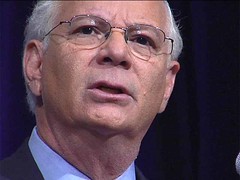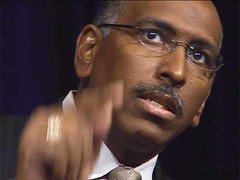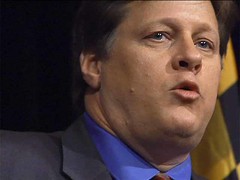


(The above shots were all captured with the Panasonic HVX200, set to low resolution.)
"You can remember the dumbest things from your childhood, but you can never recall what you did yesterday."
I sit in the photo department while Gene works on photos of John (TV's "Gomez Addams") Aston, who now works as a film instructor at Johns Hopkins University. Gene starts singing the lyrics to the "Addams Family," and it starts getting in my head:
"They're creepy and they're kooky;
"Mysterious and spooky.
"They're alltogether ooky;
the Addams Family."
Gene couldn't help but sing the song, and it starts to get to me.
"You're putting that song in my head!" I yell from the back room. ""It's been in mine all afternoon!" Gene yells from a workstation as he tones the pictures he shot.
I just got finished with burning 5 DVD's after shooting more footage of the US Senate candidates at the harbor Marriott, earlier in the day. This time we had the trifecta: Michael Steele (R), Ben Cardin (D), and Kevin Zeese of the Libertarian Party attended the forum. Fortunately for me (and the gear I had), the candidates all agreed to allow each one the floor so he could answer a series of questions posed by a moderator. As the media signed in, the volunteer at the door commented about how many people from our work were there. Little did she know that Andre would arrive soon after to shoot stills, while John came to capture audio.
Each candidate had around 15 minutes to answer the questions, plus 3 minutes for a closing statement.
My HVX200, when shooting NTSC standard def video, can shoot 16 minutes per 4gb card. I only have 2 cards. So I decided to try "hot-swapping," where I would grab each full card from the back of the camera and download the data onto my PowerBook. The speed of the video card was fine for standard 480p, but all I wanted to do was transfer the MXF files to clear the disk.
First was Michael Steele, who gave his answers and closing statement. As Steele began, Andre started banging off frames with his camera, just to the left of me. Wishing I had an on-camera wireless system like the guy to my right, I could only glare towards Andre (my first time being upset about a still photographer's camera noise) while hoping that John was getting some audio that we could use, since I knew mine would be too spoiled for use. As the first card filled, I watched as the green light blinked and time dropped to about 16 minutes remaining, which is the halfway point, and when the cards would swap over, since the first card would have filled with data. When the light changes to green, you can remove it, but not during recording, when it blinks amber.
After the first P2 card filled, I removed it and inserted it in the PCMCIA card on the side of the Powerbook. It was filled with 3.54gb of the camera's native "MXF" files (which can be converted to movie files through Final Cut Pro). Transferring the data takes around 10 minutes, so I was really cutting everything pretty close. I grabbed my Lumix DMC-FZ30 to get ready just in case I ran out of space on the HVX, so I started shooting some "B-roll" with the camcorder feature. But Steele finished with several minutes to spare, and the forum called for a short break, so I transferred the data from the second P2 card and returned them to the HVX200 and reformatted each card, just in time for Kevin Zeese to take center stage.
I started getting into a rhythm of streamlining by wiping the P2 card on the laptop as the HVX recorded nearby. I started moving throughout the audience, getting more B-roll and angles as Zeese finished and Cardin began, just in time for another full P2 transfer and drink of water. But as Cardin was in the heart of his responses, my PowerBook warned that the disk drive was almost full! And I had to return the P2 card to capture his closing remarks. As the card's files transferred, there were less than 60 megabytes of free space left on my laptop -- talk about squeezing the files in!
But then, the other foot began to step on mine: As Cardin answered the final question, I showed only 3 minutes remaining on the first card in the HVX. Quickly, I opened the second camera card and unlocked the text file so I could drag it into the trash and delete the files, giving me a free card again. Just in time, I returned the free card into the port of the camera, which began recording as Cardin gave his summary. As he shook hands and left the podium, I had about 4 minutes remaining, so I went outside and captured some "establishing shots" of the harbor, the skyline, and the hotel where the forum was held and headed back to the office.
Back at the photo department, my disk burning is finished. Gathering all the filing papers and DVD's together, I smile, realizing that I'm a few hours ahead of schedule, while Gene laments about the impending rainout of the Cardinals/Tigers World Series game. Calling his wife, he suggests they make print-outs of the fun jingles to some of the old television shows, like "The Jeffersons" and "Car 59," for a future road trip they're planning. Gene tries remembering the lyrics to "Gilligan's Island" and finds it tough to recall the words to "Mister Ed."
Googling "Mister Ed" and "lyrics," he gleams with excitement, and I suddenly break out with the tune, through my own childhood memory:
"A horse is a horse, of course, of course;
"And no one can talk to a horse, of course.
"That is of course unless the horse is the famous Mister Ed!"
Now, what was it that I was upset about, yesterday?
I sit in the photo department while Gene works on photos of John (TV's "Gomez Addams") Aston, who now works as a film instructor at Johns Hopkins University. Gene starts singing the lyrics to the "Addams Family," and it starts getting in my head:
"They're creepy and they're kooky;
"Mysterious and spooky.
"They're alltogether ooky;
the Addams Family."
Gene couldn't help but sing the song, and it starts to get to me.
"You're putting that song in my head!" I yell from the back room. ""It's been in mine all afternoon!" Gene yells from a workstation as he tones the pictures he shot.
I just got finished with burning 5 DVD's after shooting more footage of the US Senate candidates at the harbor Marriott, earlier in the day. This time we had the trifecta: Michael Steele (R), Ben Cardin (D), and Kevin Zeese of the Libertarian Party attended the forum. Fortunately for me (and the gear I had), the candidates all agreed to allow each one the floor so he could answer a series of questions posed by a moderator. As the media signed in, the volunteer at the door commented about how many people from our work were there. Little did she know that Andre would arrive soon after to shoot stills, while John came to capture audio.
Each candidate had around 15 minutes to answer the questions, plus 3 minutes for a closing statement.
My HVX200, when shooting NTSC standard def video, can shoot 16 minutes per 4gb card. I only have 2 cards. So I decided to try "hot-swapping," where I would grab each full card from the back of the camera and download the data onto my PowerBook. The speed of the video card was fine for standard 480p, but all I wanted to do was transfer the MXF files to clear the disk.
First was Michael Steele, who gave his answers and closing statement. As Steele began, Andre started banging off frames with his camera, just to the left of me. Wishing I had an on-camera wireless system like the guy to my right, I could only glare towards Andre (my first time being upset about a still photographer's camera noise) while hoping that John was getting some audio that we could use, since I knew mine would be too spoiled for use. As the first card filled, I watched as the green light blinked and time dropped to about 16 minutes remaining, which is the halfway point, and when the cards would swap over, since the first card would have filled with data. When the light changes to green, you can remove it, but not during recording, when it blinks amber.
After the first P2 card filled, I removed it and inserted it in the PCMCIA card on the side of the Powerbook. It was filled with 3.54gb of the camera's native "MXF" files (which can be converted to movie files through Final Cut Pro). Transferring the data takes around 10 minutes, so I was really cutting everything pretty close. I grabbed my Lumix DMC-FZ30 to get ready just in case I ran out of space on the HVX, so I started shooting some "B-roll" with the camcorder feature. But Steele finished with several minutes to spare, and the forum called for a short break, so I transferred the data from the second P2 card and returned them to the HVX200 and reformatted each card, just in time for Kevin Zeese to take center stage.
I started getting into a rhythm of streamlining by wiping the P2 card on the laptop as the HVX recorded nearby. I started moving throughout the audience, getting more B-roll and angles as Zeese finished and Cardin began, just in time for another full P2 transfer and drink of water. But as Cardin was in the heart of his responses, my PowerBook warned that the disk drive was almost full! And I had to return the P2 card to capture his closing remarks. As the card's files transferred, there were less than 60 megabytes of free space left on my laptop -- talk about squeezing the files in!
But then, the other foot began to step on mine: As Cardin answered the final question, I showed only 3 minutes remaining on the first card in the HVX. Quickly, I opened the second camera card and unlocked the text file so I could drag it into the trash and delete the files, giving me a free card again. Just in time, I returned the free card into the port of the camera, which began recording as Cardin gave his summary. As he shook hands and left the podium, I had about 4 minutes remaining, so I went outside and captured some "establishing shots" of the harbor, the skyline, and the hotel where the forum was held and headed back to the office.
Back at the photo department, my disk burning is finished. Gathering all the filing papers and DVD's together, I smile, realizing that I'm a few hours ahead of schedule, while Gene laments about the impending rainout of the Cardinals/Tigers World Series game. Calling his wife, he suggests they make print-outs of the fun jingles to some of the old television shows, like "The Jeffersons" and "Car 59," for a future road trip they're planning. Gene tries remembering the lyrics to "Gilligan's Island" and finds it tough to recall the words to "Mister Ed."
Googling "Mister Ed" and "lyrics," he gleams with excitement, and I suddenly break out with the tune, through my own childhood memory:
"A horse is a horse, of course, of course;
"And no one can talk to a horse, of course.
"That is of course unless the horse is the famous Mister Ed!"
Now, what was it that I was upset about, yesterday?
No comments:
Post a Comment